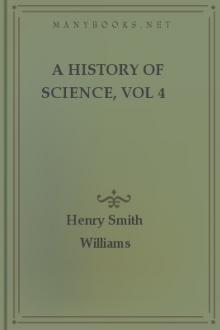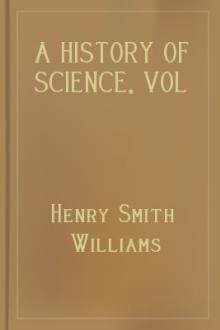A History of Science, vol 2, Henry Smith Williams [read this if txt] 📗

- Author: Henry Smith Williams
- Performer: -
Book online «A History of Science, vol 2, Henry Smith Williams [read this if txt] 📗». Author Henry Smith Williams
“Now let us return to the thin plate of gold or silver, or the thin board of ebony, and let us lay it lightly upon the water, so that it may stay there without sinking, and carefully observe the effect. It will appear clearly that the plates are a considerable matter lower than the surface of the water, which rises up and makes a kind of rampart round them on every side. But if it has already penetrated and overcome the continuity of the water, and is of its own nature heavier than the water, why does it not continue to sink, but stop and suspend itself in that little dimple that its weight has made in the water? My answer is, because in sinking till its surface is below the water, which rises up in a bank round it, it draws after and carries along with it the air above it, so that that which, in this case, descends in the water is not only the board of ebony or the plate of iron, but a compound of ebony and air, from which composition results a solid no longer specifically heavier than the water, as was the ebony or gold alone. But, gentlemen, we want the same matter; you are to alter nothing but the shape, and, therefore, have the goodness to remove this air, which may be done simply by washing the surface of the board, for the water having once got between the board and the air will run together, and the ebony will go to the bottom; and if it does not, you have won the day.
“But methinks I hear some of my antagonists cunningly opposing this, and telling me that they will not on any account allow their boards to be wetted, because the weight of the water so added, by making it heavier than it was before, draws it to the bottom, and that the addition of new weight is contrary to our agreement, which was that the matter should be the same.
“To this I answer, first, that nobody can suppose bodies to be put into the water without their being wet, nor do I wish to do more to the board than you may do to the ball. Moreover, it is not true that the board sinks on account of the weight of the water added in the washing; for I will put ten or twenty drops on the floating board, and so long as they stand separate it shall not sink; but if the board be taken out and all that water wiped off, and the whole surface bathed with one single drop, and put it again upon the water, there is no question but it will sink, the other water running to cover it, being no longer hindered by the air. In the next place, it is altogether false that water can in any way increase the weight of bodies immersed in it, for water has no weight in water, since it does not sink. Now just as he who should say that brass by its own nature sinks, but that when formed into the shape of a kettle it acquires from that figure the virtue of lying in water without sinking, would say what is false, because that is not purely brass which then is put into the water, but a compound of brass and air; so is it neither more nor less false that a thin plate of brass or ebony swims by virtue of its dilated and broad figure. Also, I cannot omit to tell my opponents that this conceit of refusing to bathe the surface of the board might beget an opinion in a third person of a poverty of argument on their side, especially as the conversation began about flakes of ice, in which it would be simple to require that the surfaces should be kept dry; not to mention that such pieces of ice, whether wet or dry, always float, and so my antagonists say, because of their shape.
“Some may wonder that I affirm this power to be in the air of keeping plate of brass or silver above water, as if in a certain sense I would attribute to the air a kind of magnetic virtue for sustaining heavy bodies with which it is in contact. To satisfy all these doubts I have contrived the following experiment to demonstrate how truly the air does support these bodies; for I have found, when one of these bodies which floats when placed lightly on the water is thoroughly bathed and sunk to the bottom, that by carrying down to it a little air without otherwise touching it in the least, I am able to raise and carry it back to the top, where it floats as before. To this effect, I take a ball of wax, and with a little lead make it just heavy enough to sink very slowly to the bottom, taking care that its surface be quite smooth and even. This, if put gently into the water, submerges almost entirely, there remaining visible only a little of the very top, which, so long as it is joined to the air, keeps the ball afloat; but if we take away the contact of the air by wetting this top, the ball sinks to the bottom and remains there.
Now to make it return to the surface by virtue of the air which before sustained it, thrust into the water a glass with the mouth downward, which will carry with it the air it contains, and move this down towards the ball until you see, by the transparency of the glass, that the air has reached the top of it; then gently draw the glass upward, and you will see the ball rise, and afterwards stay on the top of the water, if you carefully part the glass and water without too much disturbing it.”[3]
It will be seen that Galileo, while holding in the main to a correct thesis, yet mingles with it some false ideas. At the very outset, of course, it is not true that water has no resistance to penetration; it is true, however, in the sense in which Galileo uses the term—that is to say, the resistance of the water to penetration is not the determining factor ordinarily in deciding whether a body sinks or floats. Yet in the case of the flat body it is not altogether inappropriate to say that the water resists penetration and thus supports the body. The modern physicist explains the phenomenon as due to surface-tension of the fluid.
Of course, Galileo’s disquisition on the mixing of air with the floating body is utterly fanciful. His experiments were beautifully exact; his theorizing from them was, in this instance, altogether fallacious. Thus, as already intimated, his paper is admirably adapted to convey a double lesson to the student of science.
WILLIAM GILBERT AND THE STUDY OF MAGNETISM
It will be observed that the studies of Galileo and Stevinus were chiefly concerned with the force of gravitation. Meanwhile, there was an English philosopher of corresponding genius, whose attention was directed towards investigation of the equally mysterious force of terrestrial magnetism. With the doubtful exception of Bacon, Gilbert was the most distinguished man of science in England during the reign of Queen Elizabeth. He was for many years court physician, and Queen Elizabeth ultimately settled upon him a pension that enabled him to continue his researches in pure science.
His investigations in chemistry, although supposed to be of great importance, are mostly lost; but his great work, De Magnete, on which he labored for upwards of eighteen years, is a work of sufficient importance, as Hallam says, “to raise a lasting reputation for its author.” From its first appearance it created a profound impression upon the learned men of the continent, although in England Gilbert’s theories seem to have been somewhat less favorably received. Galileo freely expressed his admiration for the work and its author; Bacon, who admired the author, did not express the same admiration for his theories; but Dr.
Priestley, later, declared him to be “the father of modern electricity.”
Strangely enough, Gilbert’s book had never been translated into English, or apparently into any other language, until recent years, although at the time of its publication certain learned men, unable to read the book in the original, had asked that it should be. By this neglect, or oversight, a great number of general readers as well as many scientists, through succeeding centuries, have been deprived of the benefit of writings that contained a good share of the fundamental facts about magnetism as known to-day.
Gilbert was the first to discover that the earth is a great magnet, and he not only gave the name of “pole” to the extremities of the magnetic needle, but also spoke of these “poles” as north and south pole, although he used these names in the opposite sense from that in which we now use them, his south pole being the extremity which pointed towards the north, and vice versa. He was also first to make use of the terms “electric force,” “electric emanations,” and “electric attractions.”
It is hardly necessary to say that some of the views taken by Gilbert, many of his theories, and the accuracy of some of his experiments have in recent times been found to be erroneous. As a pioneer in an unexplored field of science, however, his work is remarkably accurate. “On the whole,” says Dr. John Robinson, “this performance contains more real information than any writing of the age in which he lived, and is scarcely exceeded by any that has appeared since.”[4]
In the preface to his work Gilbert says: “Since in the discovery of secret things, and in the investigation of hidden causes, stronger reasons are obtained from sure experiments and demonstrated arguments than from probable conjectures and the opinions of philosophical speculators of the common sort, therefore, to the end of that noble substance of that great loadstone, our common mother (the earth), still quite unknown, and also that the forces extraordinary and exalted of this globe may the better be understood, we have decided, first, to begin with the common stony and ferruginous matter, and magnetic bodies, and the part of the earth that we may handle and may perceive with senses, and then to proceed with plain magnetic experiments, and to penetrate to the inner parts of the earth.”[5]
Before taking up the demonstration that the earth is simply a giant loadstone, Gilbert demonstrated in an ingenious way that every loadstone, of whatever size, has definite and fixed poles.
He did this by placing the stone in a metal lathe and converting it into a sphere, and upon this sphere demonstrated how the poles can be found. To this round loadstone he gave the name of terrella—that is, little earth.
“To find, then, poles answering to the earth,” he says, “take in your hand the round stone, and lay on it a needle or a piece of iron wire: the ends of the wire move round their middle point, and suddenly come to a standstill. Now, with ochre or





Comments (0)